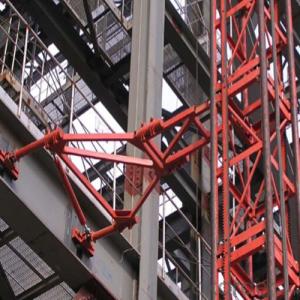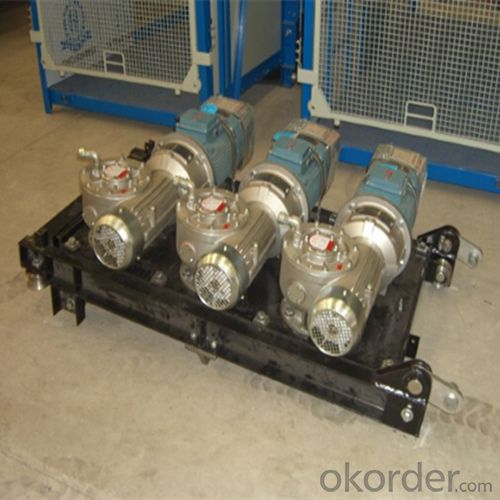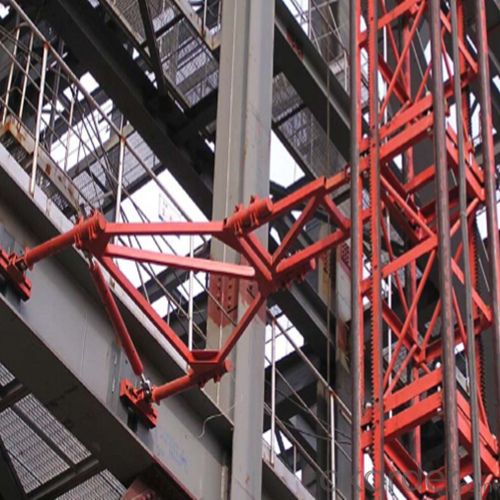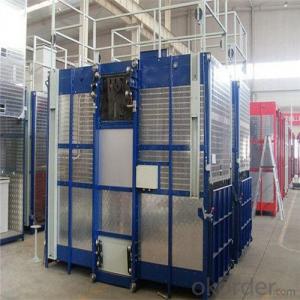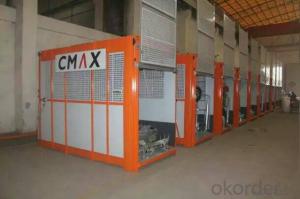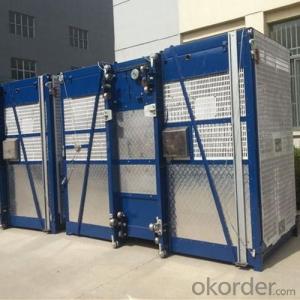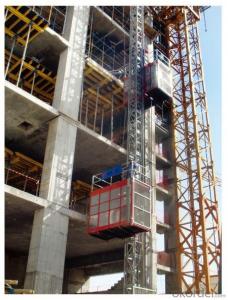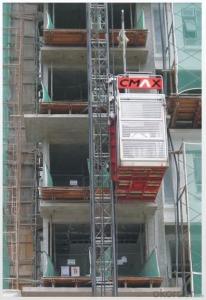Building Hoist lifter Frequency Conversioon
- Loading Port:
- China main port
- Payment Terms:
- TT or LC
- Min Order Qty:
- 1 unit
- Supply Capability:
- 30 unit/month
OKorder Service Pledge
OKorder Financial Service
You Might Also Like
Structure of Building Hoist Description
Feature: Building Hoist Condition: New Application: Construction
Payload(kg):2700 Lifting Speed(m/min):0~60 Motor Power(kw): 3*18.5
Safety Device: SAJ50-1.4 Cage: Single Counterweight: No
Certification: CE,ISO Place of Origin: China(Mainland) Model Number: Type:SC270
Packaging & Delivery of Building Hoist
Packaging Detail: Nude package Delivery Detail: 25-30days
Main Parts of Building Hoist
● Adopts the most advanced VF speed control device and microcomputer programmable logic controller.
● Stepless speed control helps eliminate the concussion during start up and braking, steady the operation process,
and ensures automated leveling.
● Adopts open loop V/Fcontrol; the speed control precision can reach ±2~3%. Realizes accurate low speed positioning of the hoist and avoid slipping during downward stopping of hoist.
● The VF system has current-restriction function, ensuring a small current when motor start up and reducing the concussion to power supply. It reduces the engery consumption and mitigates effects to on site electric equipments.
● As for 650x650x1508 mast section, a 40 HQ container can be fill with 67pcs about 100m.
● Aftersales service such as installation supervision and guidance, training is available. But the cost of tickets, accommodation and allowance for one person per day is paid by custoner
● The system applies the special software for hoists developed by our company, making the operation more safe and
reliable.
Building Hoist Images
CMAX Building Hoist
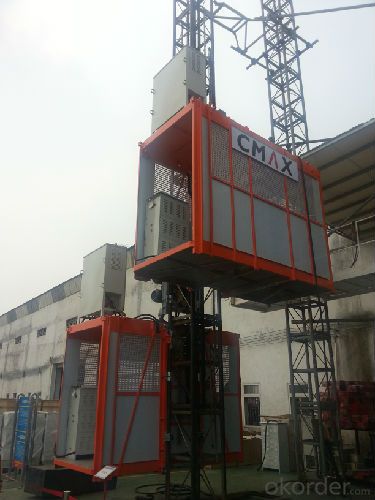
Nord Motors
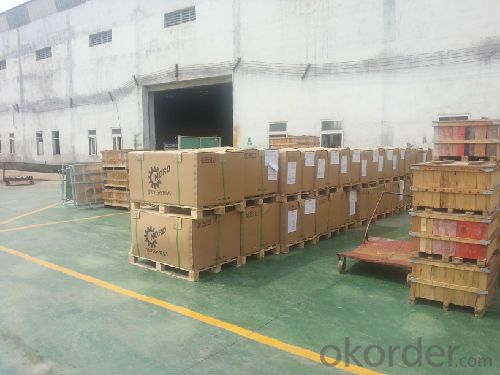
Inverter
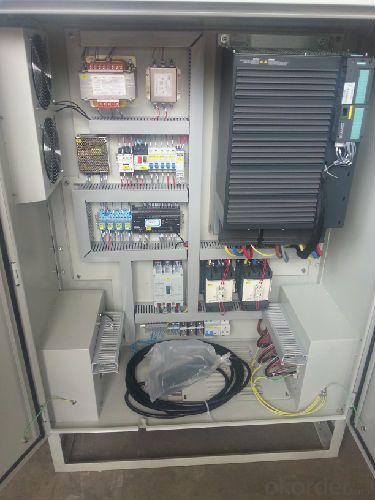
Building Hoist Specifiction
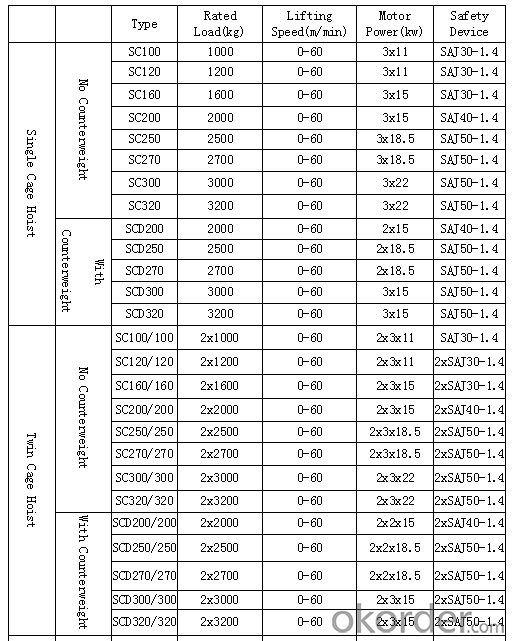
FAQ of Building Hoist
Q: What is the building hoist main purpose?
A: Building hoist equipped with double or single cabin to transport the materials and labors up and down. It's the ideal
construction equipment for vertical transportation in the field of construction.
Q: What is the main structure of building hoist?
A: The P/M construction hoist mainly contains metal structure, driving system, electrical control system, cable guide &
protection system, electrical top crane and safety device.
Q: What is the meaning of the building hoist’s code?
A: Take SC200/200 for example: “SC” stands for rack and pinion hoist, “200/200” stands for double cage and capacity
is 2 tons per cage. “SC200” stands for single cage and capacity is 2 tons.
- Q: This question asks for examples of typical uses for building hoists, which are devices used to lift materials in construction settings.
- <p>Building hoists are commonly used in various construction applications. They are utilized for lifting and lowering materials and personnel in high-rise construction projects. Some examples include: 1) Lifting building materials such as bricks, cement, and steel beams to different floors of a building under construction. 2) Transporting workers to elevated work areas for tasks like scaffolding assembly or window installation. 3) Moving heavy equipment to upper levels of a structure. 4) Assisting in the installation of large fixtures like HVAC systems or electrical wiring systems. 5) Facilitating the removal of construction waste from upper floors. These applications highlight the versatility and efficiency of building hoists in construction projects.</p>
- Q: A building hoist is a piece of equipment used in construction to lift materials and personnel.
- <p>A building hoist, also known as a construction hoist or material hoist, is a temporary lifting device used in the construction industry to transport materials, equipment, and sometimes personnel vertically within a building under construction. It is essential for efficient movement of heavy and bulky items, reducing manual labor and improving safety by minimizing the need for workers to climb ladders or handle heavy loads manually. These hoists are typically installed on the exterior of the building and are used throughout the construction process until the building's permanent elevators are installed and operational.</p>
- Q: Is it possible to utilize a building hoist for the purpose of lifting heavy objects or construction materials?
- <p>Yes, a building hoist is specifically designed for lifting large objects and materials in construction settings. These hoists are engineered to handle heavy loads, making them ideal for transporting construction materials, equipment, and other heavy items vertically within a building. They are equipped with safety features and are regulated to ensure they can bear the weight and pressure of the materials being lifted, thus playing a crucial role in the construction process.</p>
- Q: Is it possible to replace an electric control panel with a manual lever in a lifting system?
- <p>While it is theoretically possible to use a manual lever as a substitute for an electric control panel in a lifting system, it is not advisable. Manual levers lack the precision, safety features, and control capabilities of electric control panels. They also cannot provide the same level of feedback or automation. Electric control panels are designed to ensure safe and efficient operation, with features like emergency stop buttons, overload protection, and remote monitoring. Manual levers can pose safety risks and may not meet the operational requirements of modern lifting systems.</p>
- Q: What are the primary materials and components typically utilized in the construction of building hoists?
- <p>Building hoists, also known as construction hoists, are typically made from a combination of steel, aluminum, and sometimes plastic. The frame and main structure are usually constructed from steel for strength and durability. Aluminum is often used for components like the platform and railing due to its lightweight properties, which can reduce the overall weight of the hoist. Plastic components may be used for certain parts to enhance resistance to weather and corrosion. Additionally, hoists may incorporate electrical and mechanical systems, which include cables, gears, and motors, to facilitate the hoisting and lowering of materials and personnel.</p>
- Q: How much cable does the construction elevator 44KVA need?
- 44KW three phase power: 79A, BV5X16
- Q: Is it possible to utilize a building hoist to lift objects with varying dimensions and weights?
- <p>Yes, building hoists are designed to lift a variety of objects with different sizes and weights. However, each hoist has specific weight and size limitations that must be adhered to for safety and operational reasons. It's crucial to ensure that the objects being lifted are within the hoist's capacity to prevent accidents and damage. Always consult the manufacturer's specifications and safety guidelines before using a hoist for lifting operations.</p>
- Q: Is it permissible to utilize electric or hydraulic building hoists in personal workshops or factories?
- <p>Yes, you can use an electric or hydraulic building hoist in your own workshop or factory. However, you must ensure that the hoist complies with local safety regulations and standards. It's crucial to have the hoist installed by qualified professionals and to maintain it regularly to prevent accidents. Always follow the manufacturer's guidelines and safety protocols to ensure the safe operation of the hoist.</p>
- Q: This question asks for the distinctions between two types of building hoists: manual and automatic.
- <p>Manual building hoists require human effort to operate, typically involving a pulley system and manual controls. They are generally less expensive but slower and more labor-intensive. Automatic building hoists, on the other hand, are motorized and can be programmed to lift and lower loads with minimal human intervention. They offer greater efficiency, speed, and safety, but come at a higher cost. Automatic hoists are also more suitable for high-rise construction due to their ability to handle heavier loads and operate over greater distances.</p>
- Q: Is it possible to use a building hoist for lifting lightweight items?
- <p>Yes, a building hoist can be used for lifting light objects, provided it is within the hoist's weight capacity. Building hoists are versatile and can handle various loads, but it's crucial to ensure the object's weight does not exceed the hoist's specified limit to maintain safety and prevent damage to the equipment. Always refer to the manufacturer's guidelines for the maximum load capacity and adhere to safety protocols when operating a building hoist.</p>
Send your message to us
Building Hoist lifter Frequency Conversioon
- Loading Port:
- China main port
- Payment Terms:
- TT or LC
- Min Order Qty:
- 1 unit
- Supply Capability:
- 30 unit/month
OKorder Service Pledge
OKorder Financial Service
Similar products
Hot products
Hot Searches
Related keywords



